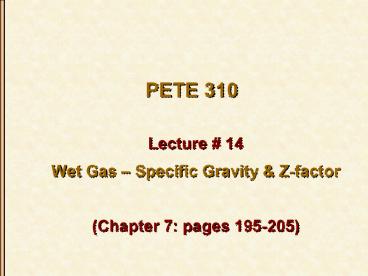PETE 310 - PowerPoint PPT Presentation
1 / 26
Title:
PETE 310
Description:
Title: PowerPoint Presentation Author: Maria A. Barrufet Last modified by: Ghost Created Date: 1/12/2000 5:05:50 AM Document presentation format: Skjermfremvisning – PowerPoint PPT presentation
Number of Views:83
Avg rating:3.0/5.0
Title: PETE 310
1
PETE 310
- Lecture 14
- Wet Gas Specific Gravity Z-factor
- (Chapter 7 pages 195-205)
2
Learning Objectives
- Calculate the specific gravity of a wet gas
mixture, given producing GOR (at separator(s) and
stock tank and - compositions liquid and gas from stock tank and
separator gas - or, separator compositions (gas liquid)
- or, properties of the separator gas and stock
vent gas - Define the two-phase z-factor and understand the
uses of this in reservoir engineering - Explain the shape of a typical two-phase z-factor
isotherm. - Calculate values of two-phase z-factor using
Rayes etal. correlation (SPE paper).
3
Separators
4
Key Points
- What matters is the molar ratio of gas to oil so
lets assume one barrel of oil produced - Methods to evaluate oil density will be discussed
in Chapter 11 (here it will be provided) - To convert oAPI to oil density
5
Key Points
- The expression means has the units of For
example - You are responsible for reading the material that
cannot be covered in this lecture - Rework ALL the example problems in the book
- Procedure 1 - explained in detail here - is
simpler and takes less time to solve than the
method explained in the book
6
Recombination procedure when separator gas yiSP
and tock tank compositions (xiSTO, yiST) are
known
- (Procedure 1.)
7
Procedure 1.
- Calculate molecular weight of stock tank liquid
- Calculate lb-moles of separator gas produced per
barrel of STO from separator
8
Procedure 1.
- Calculate lb-moles of stock gas vented per STO
- Calculate moles of oil in 1 barrel of stock tank
(need to use molar density)
9
Procedure 1.
10
Procedure 1.
- Determine reservoir gas composition from
fundamental mole balance - Once reservoir composition is known determine
z-factor and specific gravity
11
Example for Procedure 1.
X i STO
Yi SEP
Yi STO
12
Recombination procedure when separator gas yiSP
and liquid compositions xiSP are known
- (Procedure 2.)
13
Example for Procedure 2.
14
Procedure 2.
- Additional information given is the
separator/stock tank volume ratio as - Use this to convert from scf/STO ? scf/ST
- Proceed as in procedure 1.
- Rework example 7.2 in textbook
15
Recombination procedure when only separator gas
and stock vent gas properties are known
- (Procedure 3.)
16
Procedure 3.
- For two-stage separators
- For three-stage separators derive expressions
17
Procedure 3.
- Moles in one stock tank barrel
18
Procedure 3.
- Mass of one stock tank barrel
19
Procedure 3.
- And the gas gravity at reservoir conditions is
- An approximation for Mo (when not given is)
20
Procedure 3.
- For two-stage separators
- For three-stage separators derive expressions
21
Once Gas Specific Gravity is Known
- Evaluate Tpc and Ppc (previous paper using K and
J and including corrections for impurities N2,
CO2, H2S) - If dew-point pressure is not known
- Use dry-gas z-factor when C7 lt 4
- Or when wellstream gravity lt 0.911
- If pd is known
- if reservoir p is lower than pd evaluate z-2phase
using equation from SPE 20055 paper - If reservoir p is greater than pd , evaluate z
as for a dry gas (single-phase)
22
Correlation of Specific Gravitiesfor a wet gas
READ - SPE 20055
23
Ranges of Compositions
24
Single vs Two-phase z-factor
25
Estimates of the Gas in Place (G)
- When p/z 0 ? Gp G (PETE 323)
- Exercise verify these calculations using
information from next slide
26
Estimates of Reserves































